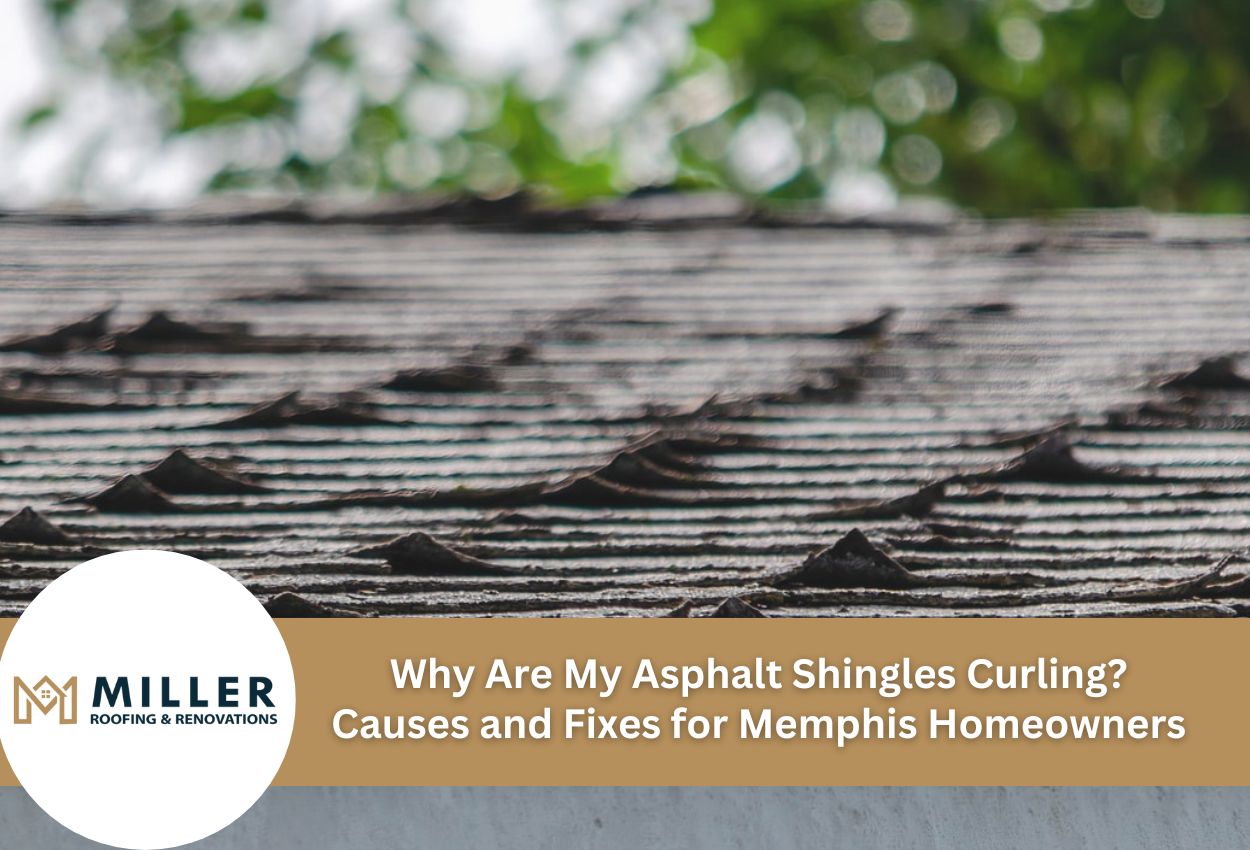Curling asphalt shingles are a common roofing problem that many Memphis homeowners face. When shingles begin to curl or buckle, they create an upward distortion at the edges or corners, leaving your roof vulnerable to water damage, leaks, and the elements. This visible deterioration is more than just an aesthetic concern — it’s often a warning sign of underlying issues that require attention.
Memphis’s hot, humid summers and occasionally harsh winters create the perfect storm for shingle damage. The constant cycle of expansion and contraction can accelerate shingle aging, while improper attic ventilation, common in local homes, can trap heat and moisture that damages roofing materials from below.
Understanding both the causes of shingle curling and the appropriate solutions can help protect your home and extend your roof’s lifespan. Some minor curling issues can be addressed with DIY approaches, while more severe cases require professional intervention from experienced roofing contractors. Recognizing when to handle the problem yourself and when to call in experts is crucial to preventing more extensive damage to your home’s structure.
Understanding the Science Behind Shingle Curling
Asphalt shingles are made of a few layers, including a fiberglass or organic material base covered with asphalt and mineral granules. This structure makes them effective at protecting homes, but also inherently vulnerable to environmental stresses. The asphalt layer contains oils that provide flexibility, but these oils naturally evaporate over time, causing the shingles to become brittle and prone to curling. The top and bottom surfaces of shingles expand and contract at different rates, creating tension that results in visible deformation.
Memphis’s climate accelerates this process significantly. Our summer temperatures regularly exceed 90 degrees Fahrenheit, causing rapid oil evaporation from shingles and creating extreme heat on roof surfaces. The high humidity levels in our region, often above 70%, compound the problem by introducing moisture beneath shingles. This moisture can cause the underlying deck to expand and contract, further stressing the roofing materials. The dramatic temperature fluctuations we experience between seasons create a continuous cycle of expansion and contraction that weakens the shingle structure over time.
Additionally, Memphis’s position in a region prone to severe weather means our roofs face harsher conditions than those in milder climates. Intense summer heat waves followed by significant temperature drops put extraordinary stress on roofing materials, making regular inspection and maintenance particularly important for homeowners in our area.
Top Causes of Asphalt Shingle Curling
Understanding why asphalt shingles curl is essential for Memphis homeowners hoping to prevent or address this common roofing issue. Environmental factors play a significant role in shingle deterioration, with excessive heat being particularly problematic in Tennessee summers. When attic temperatures soar above 150 degrees Fahrenheit due to inadequate ventilation, shingles bake from underneath, causing the edges to lift and curl. High humidity levels in Memphis can trap moisture in and under shingles, leading to warping and premature aging.
Poor installation also contributes to shingle problems. Improper nail placement, using too few nails per shingle, or nailing too high on the shingle can allow wind to lift edges and initiate curling. Many local homes suffer from overlaying new shingles on old ones, creating an uneven surface that promotes curling.
Manufacturing defects, though less common, can doom shingles from the start. Some less expensive shingles contain insufficient asphalt or use inferior materials that deteriorate quickly in our harsh Memphis climate. Age is also inevitable — most asphalt shingles in our region have a 15 to 25-year functional lifespan before natural deterioration begins. Finally, inadequate roof slope can prevent water runoff, allowing moisture to linger under shingles and accelerate curling, especially on low-pitched sections common in ranch-style homes throughout the Memphis area.
How to Assess the Severity of Your Roof’s Condition
The extent of shingle curling on your roof will determine whether repairs or replacement are the better option. Begin your assessment by examining your roof from the ground using binoculars, looking for edges that appear raised or distorted. Note areas where shingles exhibit cupping, edges turning upward, vs. clawing, middle raised with edges curving downward. Cupping typically indicates exposure to excessive moisture or sun damage, while clawing often suggests an aging roof nearing the end of its service life.
For a closer inspection, consider checking your gutters for excessive granule loss, a sign that protective materials are wearing away from your shingles. If you’re comfortable accessing your roof safely using proper fall protection and on a mild, dry day, look for signs of brittleness or cracking when you gently press on curled shingles. Severe curling that affects multiple sections of your roof, especially if accompanied by cracking or missing shingles, indicates advanced deterioration requiring prompt attention.
The timeline for addressing shingle curling varies depending on severity. Minor curling with no leaks might be monitored, while moderate curling affecting 20% to 30% of shingles typically necessitates repairs within months. Severe curling with exposed underlayment or leaks requires immediate professional attention, as these conditions can quickly lead to structural damage. Local roofing experts can provide a comprehensive evaluation to determine the most appropriate solution for your specific situation.
DIY Fixes for Minor Shingle Curling Issues
When your asphalt shingles show early signs of curling, there are several homeowner-friendly repairs that can extend your roof’s life without requiring professional intervention. Before attempting repairs, gather the necessary tools: roofing cement, look for brands specifically formulated for high-humidity environments, a caulking gun, a putty knife, roofing nails, a hammer, and protective gear, including gloves and non-slip shoes.
For best results in Tennessee’s climate, choose an asphalt-based adhesive with elastomeric properties that can withstand temperature fluctuations between seasons. Always work on your roof during mild weather — morning hours in summer or midday in cooler months provide optimal conditions for adhesive curing.
For slightly curled shingles, applying roofing cement beneath the lifted corner and gently pressing down can restore proper adhesion. This works particularly well in Memphis, where our moderate winter temperatures allow for year-round application of most roofing adhesives. Apply gentle pressure when securing curled sections, as brittle shingles can crack if forced. For shingles that resist adhesive alone, carefully placing roofing nails near the curled section can provide additional support while the cement bonds.
Remember that DIY repairs are suitable only for isolated curling issues and should be seen as temporary solutions. Widespread problems indicate deeper concerns that require professional evaluation from a qualified Memphis roofing contractor.
When to Call a Professional Roofing Contractor for Shingle Curling Services
While minor shingle curling can sometimes be addressed with DIY methods, certain situations call for professional expertise. Contact a reputable Memphis roofing contractor if curling affects more than 30% of your roof’s surface area, as this indicates systematic failure rather than isolated damage. Similarly, if you notice water stains on ceilings or walls, this suggests leaks have already developed and require immediate professional attention.
Roofs approaching or exceeding 15 years of age with curling shingles typically need professional assessment, as repairs may prove temporary and wasteful compared to replacement. Structural warning signs like sagging roof sections, visible deck deterioration, or multiple layers of existing shingles also necessitate professional intervention.
When you call a qualified Memphis roofing contractor, expect a thorough inspection. The professional will examine both exterior and interior roof components, assess ventilation systems, and identify underlying causes of the curling. They’ll document damage with photos and measurements before presenting repair or replacement options based on your specific situation.
Ask your contractor questions about warranty coverage, ventilation improvements, material recommendations suitable for Memphis weather conditions, and their approach to preventing future curling issues. Local roofing professionals understand how our region’s humidity and temperature patterns affect asphalt shingles and can recommend materials designed to withstand these challenges.
Preventing Future Shingle Curling: Maintenance Tips for Memphis Homes
Proactive maintenance is key to extending your asphalt roof’s lifespan in Memphis’s challenging climate. To protect your roof year-round, follow a seasonal maintenance schedule tailored to our local weather patterns. In spring, clear debris from gutters and roof valleys to prevent water backup during our intense summer storms. During summer, inspect for signs of heat damage and consider using a garden hose to gently clean accumulated dirt that can trap moisture and accelerate curling.
Fall maintenance is particularly crucial for Memphis homeowners — remove fallen leaves from roof surfaces and gutters to prevent moisture retention during winter. While our winters are relatively mild, periodic checks after storms help identify minor issues before they worsen. Proper attic ventilation is essential in our humid climate, as inadequate airflow can raise attic temperatures to 150 degrees Fahrenheit in summer, severely damaging shingles from beneath.
Consider installing ridge vents or additional soffit vents if your home lacks proper ventilation. Regular professional inspections every few years can identify early signs of shingle stress before visible curling occurs. Also important is managing the trees around your property. Trim branches that hang over your roof to reduce moisture retention and prevent falling debris that can damage shingle surfaces. These preventive measures are significantly more cost-effective than premature roof replacement.
Expert Shingle Roofing Solutions for Memphis Homes
If you’re dealing with asphalt shingle curling, don’t let the problem worsen. Shingle curling can lead to significant roof damage if not addressed immediately. Whether you’ve noticed slight curling or more severe buckling, it’s crucial to assess the situation accurately and take the right steps towards a solution. For minor issues, some DIY fixes may suffice, but for extensive damage, professional intervention is necessary.
Contact Miller Roofing and Renovations today at (901) 457-9405 for a comprehensive evaluation of your roof’s condition. Our team of experts is ready to restore the integrity of your roof and extend its lifespan with solutions tailored to the Memphis climate. Act now to secure your home against the elements and ensure your peace of mind.



 FREE ESTIMATE
FREE ESTIMATE